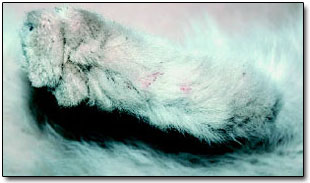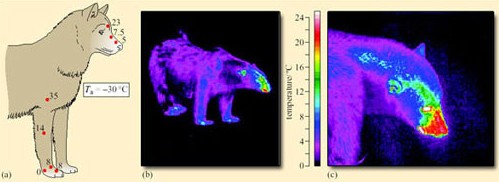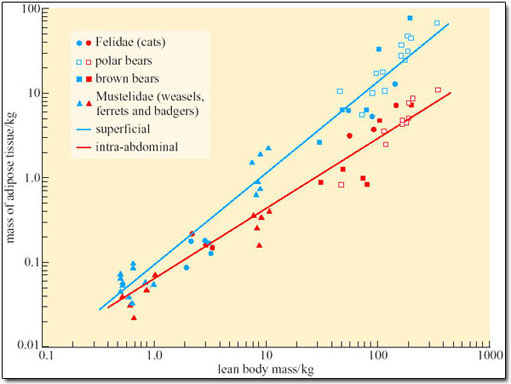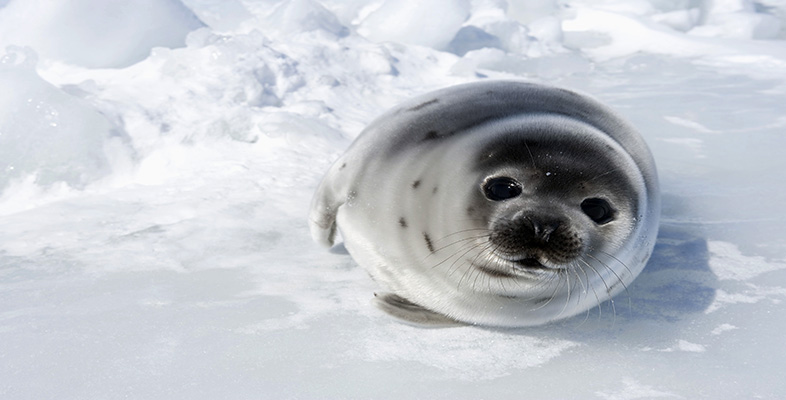4 Thermal insulation
4.1 Insulation in terrestrial endotherms
For organisms of similar size and shape in a similar thermal gradient, the rate of heat loss from convection is up to 90 times as fast in water as in air, so in temperate climates, aquatic endotherms need much more efficient insulation than terrestrial species. Since seawater freezes at −1.9° C, but the temperature of the air around the Poles can fall below −50° C, the insulation requirements of aquatic and terrestrial polar animals are not very different. Nonetheless, there are important differences in the tissues involved and in their responses to different environments. We start here with a discussion of terrestrial endotherms, then follow this aquatic endotherms and a brief discussion of humans in polar regions.
Relatively minor changes in body shape can contribute much to reducing heat loss. Polar bears have relatively small, round ears, huge, shaggy feet and the tail is much reduced. Svalbard reindeer (Figure 2b) are smaller and stockier, and have shorter ears, legs and snout than subspecies that live further south.
SAQ 22
The continental climates of northern Canada and Russia are as cold or colder than that of most of Svalbard, but the native reindeer nonetheless have long legs. What factors other than minimizing heat loss might determine their body shape?
Answer
Svalbard reindeer have no natural predators so they never run fast enough or for long enough to risk overheating. Reindeer on mainland Europe and America have long been subject to predation from wolves, which chase their prey over long distances. The need to lose excess heat while running fast may curtail the evolution of the short, stocky body form. The value of being able to see predators while the head is lowered for grazing may also account for the longer, narrow face of mainland subspecies compared to Svalbard reindeer.
The insulating properties of furs and feathers can be easily compared by wrapping pelts around heated objects such as bars and measuring their rate of cooling under various conditions. Such observations indicate that in still air, the insulation of all coats of fur or feathers is proportional to their length and thickness, but the texture and secretions from cutaneous glands produce very different properties when exposed to wind and water.
Some small arctic mammals such as lemmings and hamsters spend the winter in burrows and tunnels under the snow, where the air is effectively still all the time. Arctic foxes, and sometimes bears, shelter in snow drifts, and their young are born in dens, but in polar regions there is little shelter from plants, because trees and large shrubs are absent, and there are not many caves or other geological structures formed by flowing water. The ears of arctic foxes are reduced and thickly furred (Figure 2a) and the long, very bushy tail can provide extra insulation to any exposed part of the body when the animal is resting.
The effects of wind are important for large mammals, particularly if, like reindeer, they spend a large proportion of the time foraging in exposed places. In such animals, the outer guard hairs are long and relatively stiff, providing mechanical protection and support for the fine, dense underfur that traps layers of warm air near the skin. Stiff outer feathers and fluffy down combine to insulate birds in much the same way.
In polar homeotherms, fur or feathers often extends over parts of the body that are usually naked in temperate-zone species: the feathers extend along the legs and over the feet of ptarmigan (Figure 5) and snowy owls, and the pawpads of arctic foxes and arctic hares are covered in short, tough fur (Figure 17). The fur of Svalbard reindeer is longer and denser than that of Norwegian reindeer and it covers the ears, eyelids, snout, lips and feet much more extensively.

SAQ 23
Could there be any disadvantages in fur covering all parts of the body?
Answer
The animal's ability to dissipate heat during strenuous exercise or in warm weather is reduced and it risks overheating. When overheated, seals hold their flippers up in the wind or try to get back into water. Reindeer, bears and other terrestrial mammals pant vigorously, but hyperthermia is a real risk, especially for very large or pregnant specimens. The need to dissipate heat during prolonged, strenuous exercise may be one reason why the large hunters, such as wolves, which occur throughout the Russian and Canadian Arctic, are not completely covered in thick fur. In husky dogs (and their wolf ancestors), counter-current blood flow in the legs and nose results in much lower temperatures of the peripheral parts of these organs (Figure 18a), greatly reducing heat loss from them. When the animals are asleep, they tuck their feet and nose into their coat or cover them with the thickly furred tail, but they avoid overheating during long chases by retaining some exposed surfaces through which heat can be lost rapidly. All animals with wettable fur lose heat faster when wet, and most species, including polar bears, shake themselves vigorously immediately after swimming (as dogs do).

Figures 18b and 18c show similar information obtained by infrared thermography of a free-living polar bear standing on snow in the Canadian Arctic. The nose, mouth, eyes and ears are warm relative to the rest of the body, and are thus the sites of the greatest heat loss per unit area.
SAQ 24
Do the measurements in Figure 18b suggest that this bear was under thermal stress (i.e. too hot or too cold)?
Answer
No. Its feet and lower legs are emitting a moderate amount of heat. Heat lost from the feet would be much curtailed if the animal was too cold, or greatly increased if it was too hot, e.g. after running, as happens in many mammals, including dogs (Figure 18a) and to some extent in ourselves.
SAQ 25
In which of the warm structures revealed by Figure 18c is the high temperature due to (a) rich perfusion with blood or (b) high intrinsic metabolic rate?
Answer
(a) The external ear, eyelids, nose and mouth receive a rich blood supply (even very small wounds bleed profusely), bringing warm blood from the body core to the surface. (b) In contrast, the outer surface of the eye is not perfused with blood (except transiently at the site of injury or infection, when the damaged eye becomes ‘bloodshot’). Its heat is produced locally by the very high metabolic rate of the transparent tissues (lens and cornea) and the numerous tiny neurons that comprise the retina (light-sensitive surface) and the optic nerve.
SAQ 26
Why do bears (and people) keep their eyes almost closed in strong winds and cold weather?
Answer
Figure 18c shows that the surface of the eyeball was above 26° C, the highest surface temperatures recorded from this bear. Even a thin covering such as eyelids would significantly reduce heat loss (as well as protecting the eye from freezing and drying). So arctic animals, especially large species standing out in the wind, view the world through narrow, slit-like eyelids, which confers an aloof, imperious expression.
The surface temperatures of red foxes, kit foxes (another temperate-zone species native to USA) and arctic foxes at air temperatures from −25 to +30° C have also been compared using infrared thermography, producing images such as those shown in Figures 18b and c. There were surprisingly few differences: all foxes lost heat through their legs, paws, ears and snout, but while the two temperate-zone species also lost heat through their thinly furred forehead, this area of the arctic fox is efficiently insulated. In the winter, the forehead of arctic foxes is covered in long, dense fur (Figure 2a), making the animal look like a pet dog, but far from being a trivial character, this tuft of fur is an integral part of the species' adaptation to extreme cold. It is greatly reduced in the greyish-brown summer pelt.
People's breath freezes on beards and eyelashes but ice does not accumulate on the fur of many arctic mammals, notably that of arctic foxes, wolves and wolverines, probably because the microscopic structure of the hair surface and/ or oily secretions from the skin prevent the formation of ice-crystals. Arctic people value such fur, particularly for trimming hoods and mufflers, although it is less soft and silky than mink.
For reasons associated with the erratic food supply (Section 1.2), many arctic mammals are obese, particularly in the winter, a situation that has led to the notion that thick subcutaneous adipose tissue makes an important contribution to insulation. As long ago as the 1950s, measurements on people swimming the English Channel and on men on polar expeditions failed to reveal any firm association between thickness of superficial adipose tissue and the capacity to withstand exposure to cold. Nonetheless, statements that subcutaneous adipose tissue is superficial because it is essential to insulation still appear in many recent textbooks.
SAQ 27
How could you test the hypothesis that subcutaneous adipose tissue is important for thermal insulation?
Answer
The hypothesis predicts that there is normally a thermal gradient across the adipose tissue. In practice, it is quite difficult to measure such a thermal gradient over a long period, and demonstrating it would not prove that adipose tissue (rather than any other superficial tissue such as muscle) is essential to insulation.
Another approach is to compare the partitioning of adipose tissue between internal and superficial depots in arctic and tropical species and look for evidence of selective expansion of the superficial fat in homeothermic animals adapted to cold climates. Polar bears eat seals, and occasionally swim long distances in ice-cold water between hunting grounds. Ice conditions often make their prey inaccessible, forcing them to fast for long periods (Section 3.2), so bears fatten when prey are readily available and are usually obese for large parts of the year. These facts have given rise to the idea that, as in fully marine mammals such as walruses and polar cetaceans (that are often found in the same habitats), adipose tissue makes an important contribution to insulation in polar bears. The data in Figure 19 (Pond and Ramsay, 1992) enable us to test this hypothesis directly. The order Carnivora includes species that share a common ancestry and many habits and range in size from weasels (with a body mass of about 0.1 kg) to bears (with a body mass of up to 700 kg) and are adapted to live in very hot (e.g. Rüppell's fox) and very cold (e.g. arctic fox, polar bear) climates.

SAQ 28
Is the partitioning of adipose tissue between internal and superficial depots in semi-aquatic arctic polar bears different from that in fully terrestrial temperate-zone carnivores?
Answer
No. The mass of the intra-abdominal depots becomes proportionately smaller and that of the superficial adipose tissue larger with increasing body mass in all species studied. The data for polar bears lie close to the regression lines fitted to the data from the temperate-zone species. There is no evidence for adaptive redistribution of adipose tissue in polar bears. Their skin is warm to the touch and the coarse guard hairs and woolly underfur are probably the principal insulating tissues. The distribution of adipose tissue in mammals native to cold freshwater, such as otters, beavers and muskrats, is also not different from that of related terrestrial species (e.g. badgers, squirrels and lemmings, respectively), providing no evidence that their adipose tissue is adapted to function as an insulator.
As much as 50% of the body mass of large adult bears can be lipid, and selective expansion of the superficial adipose depots relative to the internal depots seems to arise mainly because ‘there is nowhere else for so much fat to go’. The surface area also declines with size in animals of similar shape, so the superficial layer of adipose tissue becomes thicker with increasing body mass, even if it does not become proportionately more massive. There is also proportionately more superficial adipose tissue in large, naturally obese birds: the subcutaneous depots amount to more than 80% of the total adipose tissue in emperor penguins.
